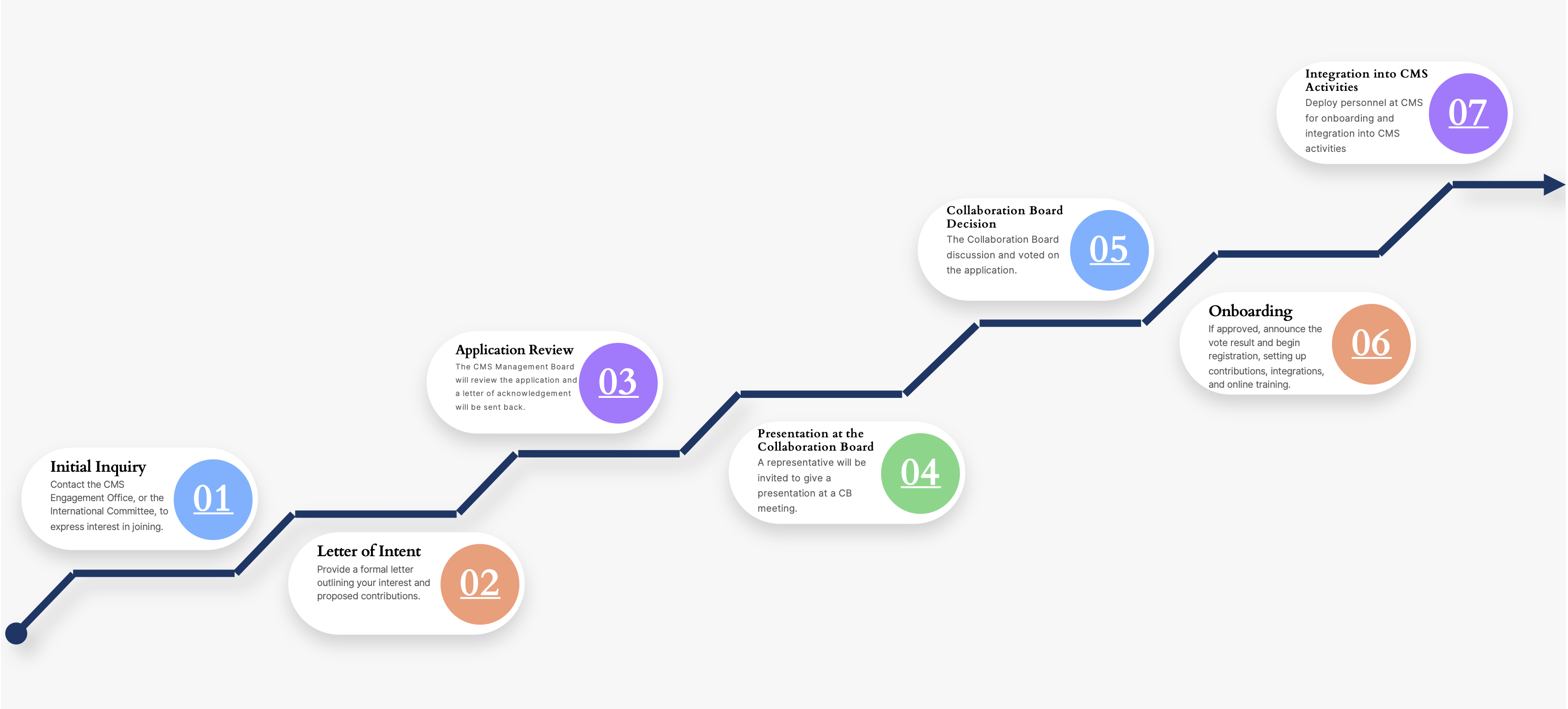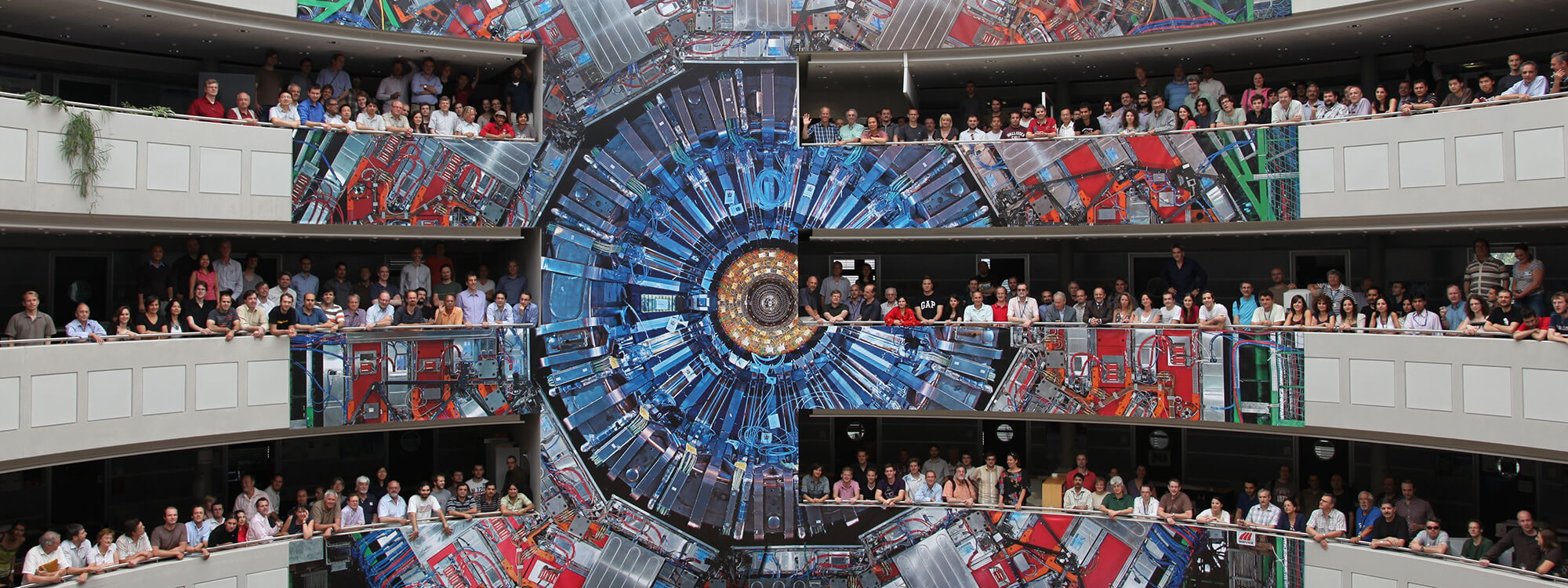The CMS Collaboration
The CMS Collaboration is a consortium of academic institutions that work together to build, operate and maintain the CMS detector. Scientists from these member institutions analyze data recorded by CMS, exploiting the full physics potential of the Large Hadron Collider at CERN.
The collaboration’s structure, objectives, governance, and the rights and obligations of the collaborating institutes, are defined in a formal constitution. Compliance with this constitution is ensured through Memoranda of Understanding (MoU), signed by Funding Agencies on behalf their respective institutes, and by CERN as the host laboratory.
A key principle of the CMS Collaboration is an equitable sharing of responsibilities related to the construction, operation, maintenance and upgrades of the detector, whilst allowing all CMS members freedom to pursue science exploitation activities of their choice.
Types of Membership
There are four ways in which institutes can participate in CMS. Institutes with FULL MEMBERSHIP benefit from being a member of a leading international scientific community. They actively contribute to technology development, data processing and computing, and physics analysis. For institutes wishing to join the collaboration, but whose resources initially preclude full membership, three additional participation categories are available, each offering a meaningful but more restricted role. SINGLE FACULTY MEMBERSHIP: a new institute with a single faculty member may join CMS provided faculty member has been active for three years as a scientist, with Maintenance and Operations (M&O) contributions paid at the time the institute applies for this status. COOPERATING INSTITUTE: new institutions may join as a cooperating institute for a limited period. This allows them to gain experience in a global collaboration as a stepping-stone toward full membership. ASSOCIATED INSTITUTES: associated institutes collaborate on technical aspects such as engineering or computing, for an indefinite period, to the mutual benefit of both parties.
These participation model ensure a flexible and inclusive framework, enabling diverse institutions to contribute to and benefit from the CMS collaboration. For more information, please contact the Engagement Office Chair on: cms-engagement-office-chair@cern.ch.
FULL MEMBERSHIP
Institutions with full membership in the CMS Collaboration hold a comprehensive set of rights and obligations. Full member institutions are represented on the Collaboration Board, the highest decision-making body of CMS, where major issues are discussed and decided through voting. Every institution with at least three physicists paying M&O in the current year has equal voting rights. Privileges for Full Member Institutions:
- The opportunity to sign all CMS physics and technical publications.
- Eligibility to assume leadership and coordination roles across all CMS activities.
Obligations of Full Member Institutions:
- Financial Contributions: Full members are required to contribute to the operational and upgrade costs of the detector, in line with the Maintenance and Operations (M&O) resources and CMS upgrade projects.
- Operational Contributions: Institutes must also provide practical support for the experiment’s operation, which includes contributions tracked through the Experimental Physics Responsibility (EPR) credit system and participation in central shifts.
While financial contributions may be partially met through in-kind contributions of deliverables in technical areas, direct contributions for operational costs, common funds, and upgrade projects are still expected. The level of required financial and operational contributions is determined based on the number of PhD-level (or equivalent) authors affiliated with the institute. For more detailed information, please request the document titled "Full Member Institute Responsibilities in CMS."
SINGLE FACULTY INSTITUTE (SFI)
The Single Faculty Institute (SFI) status allows an institute with a single faculty member, actively engaged in CMS, to join the Collaboration with limited rights, deferring the payment of the usual entry fee for new institutes. To be eligible, the faculty member must have been active for at least three years, with M&O contributions paid, at the time of applying for SFI status.
An institute with SFI status will appear in the CMS membership list, with a footnote explaining its status. The institute has observer membership on the Collaboration Board, with no voting rights, and cannot form a voting cluster with other institutes.
Obligations for SFI:
- The institute must make the normal contribution to the M&O costs and fulfill the required Experimental Physics Responsibilities (EPR) and central shifts.
- The application process for SFI status is the same as for full membership.
Review and Transition: The status of all SFIs will be reviewed at least every three years by the Collaboration Board, which may decide to terminate the status, typically in agreement with the institute. If additional members join the institute with M&O contributions paid, the institute must notify the Collaboration Board Chair and request recognition of its transition to full membership.
COOPERATING INSTITUTE
The Cooperating Institute status is a temporary arrangement designed for new institutions seeking to join CMS. It provides the opportunity to gain experience in analyzing physics data and using collaboration tools while working towards full membership. The maximum duration of this status is typically around five years.
Privileges of Cooperating Institutes:
- Contribution to specific and well-defined technical projects and physics analyses, allowing for valuable hands-on experience.
- Signing papers to which they have made direct contributions.
- Participation in Collaboration Board discussions through the Team Leader, without voting rights.
There is no mandatory financial contribution requirement for Cooperating Institutes. However, they are expected to cover the direct costs of their participation. Financial and EPR contributions made during this phase are credited towards achieving full membership.
ASSOCIATED INSTITUTE
The Associated Institute status is designed for groups contributing particular expertise in engineering or computing, but not necessarily intending to participate in physics analysis.
Privileges of Associated Institutes:
- Contribution to specific technical projects, including engineering or computing tasks.
- Opportunity to use CMS activities to educate students or attract new funding for their projects.
- No expectation to engage in physics analyses.
- Participation in Collaboration Board discussions through the Team Leader, without voting rights.
Like the Cooperating Institute status, Associated Institutes are not required to make specific financial contributions but must cover the direct costs of their participation.
Procedure for joining CMS
In the first instance, an institution wishing to join the collaboration should contact the CMS Spokesperson to express its interest. While discussions can begin informally, the official process must be initiated by submitting a formal Letter of Intent to the Spokesperson team ( cms-spokesperson-and-deputies@cern.ch ) and cc to the Engagement Office (EO) Chair ( cms-engagement-office-chair@cern.ch ) and the Collaboration Board Chair team ( cms-cbchairteam@cern.ch ).
The Spokesperson will then present the application to the CMS Management Board (MB) to assess how the new collaborators might be integrated into the collaboration. An acknowledgment email will be sent by the Spokesperson to the applying institution.
Based on institution interests and the discussion at the MB, the EO chair will coordinate with institute, sub-system managers, and/or coordinators to identify suitable tasks. The CMS Resources Manager (RM) will then request information regarding the viability and means of the necessary financial contributions.
After this exchange of information, the Chair of the Collaboration Board, the Spokesperson, the Resources Manager, and the EO Chair will arrange a meeting with the applicants and a representative from the relevant Funding Agency to discuss the terms of entry in detail.
The institute must respond to the RM with a letter from the Institute Director, confirming their understanding of the required financial and operational contributions and their commitment to fulfilling them.
The Team Leader from the prospective institute will then be invited to give a brief presentation at a Collaboration Board meeting. The presentation should cover the composition and interests of the research group, their relevant experience, and their proposed contributions to collaboration activities. Following the presentation, the Collaboration Board will discuss the application, and any questions raised will be sent back to the applicants for clarification. A final decision on admission will be made soon after the following Collaboration Board meeting via an electronic vote of the Collaboration Board.


